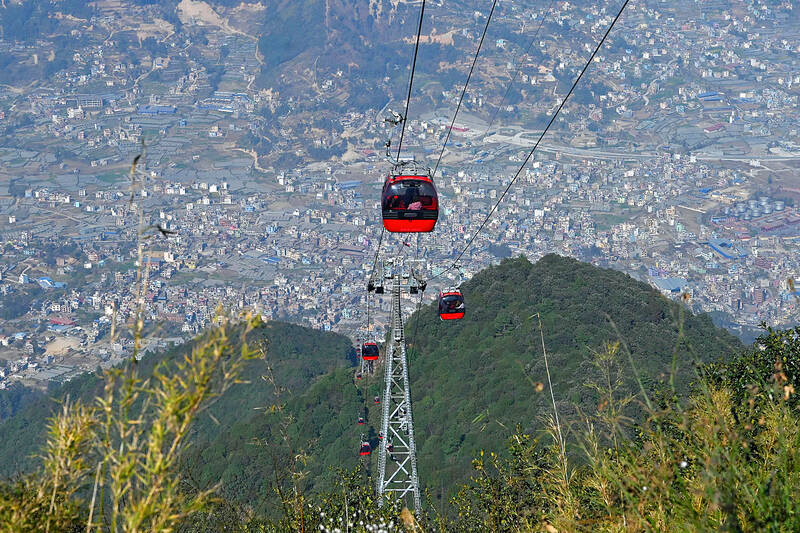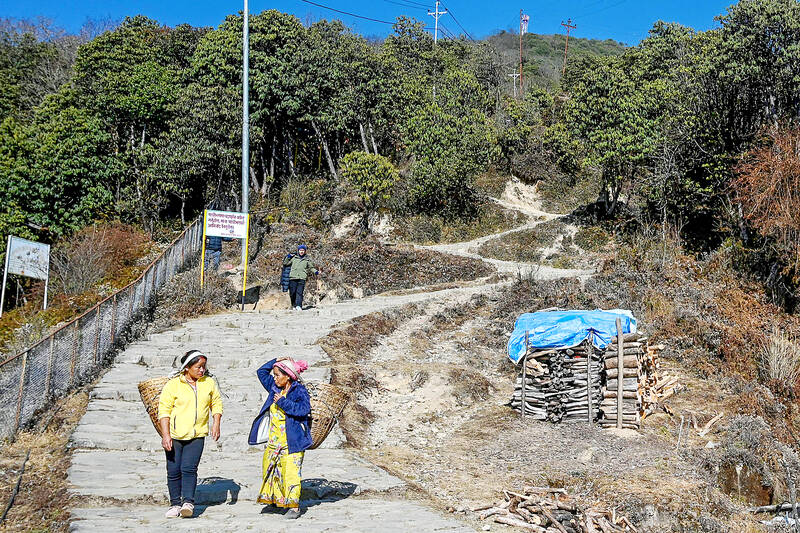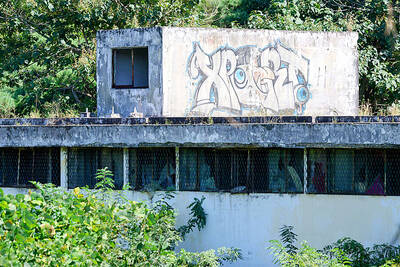They appear tranquil soaring above Himalayan forests, but a string of cable car projects in Nepal have sparked violent protests, with locals saying environmental protection should trump tourism development.
In Nepal’s eastern district of Taplejung, the community has been torn apart by a US$22 million government-backed project many say would destroy livelihoods and damage ancient forests they hold as sacred.
Across Nepal, five cable car projects have opened in the past two years — and 10 more are under development, according to government data.

Photo: AFP
Critics accuse the government of failing to assess the environmental impact properly.
Protests in Taplejung last month escalated into battles with armed police, with four activists wounded by gunfire and 21 police officers injured.
The protests calmed after promises construction would be suspended, but erupted again this week, with 14 people wounded on Thursday — 11 of them members of the security forces.

Photo: AFP
“We were in a peaceful protest, but hired thugs showed us kukris [large knives] and attacked us — and we countered them,” protest committee leader Shree Linkhim Limbu said after the latest clashes.
He vowed to continue demonstrations until the project is scrapped.
About 300,000 Hindu devotees trek for hours to Taplejung’s mountaintop Pathibhara temple every year — a site also deeply sacred to the local Limbu people’s separate beliefs.
Chandra Prasad Dhakal, a businessman with powerful political ties who is also president of Nepal’s Chamber of Commerce and Industry, in 2018 announced the construction of a 2.5km cable car to the temple.
The government calls it a project of “national pride.”
Dhakal’s IME Group is also building other cable cars, including the 6.4km Sikles line in the Annapurna Conservation Area, which the Nepalese Supreme Court upheld.
The government deemed the project a “national priority,” thereby exempting it from strict planning restrictions in protected areas.
The Supreme Court scrapped that controversial exemption last month, a move celebrated by environmentalists, but activists fear the project could still go ahead.
Taplejung is deeply sacred to local Mukkumlung beliefs, and residents say that the clearance of about 3,000 rhododendron trees — with 10,000 more on the chopping block — to build pylons is an attack on their religion.
“It is a brutal act,” Limbu said. “How can this be a national pride project when the state is only serving business interests?”
Saroj Kangliba Yakthung, 26, said locals would rather efforts and funding were directed to “preserve the religious, cultural and ecological importance” of the forests.
The wider forests are home to endangered species, including the red panda, black bear and snow leopard.
“We worship trees, stone and all living beings, but they are butchering our faith,” said Anil Subba, director of the Kathmandu-based play Mukkumlung, which was staged for a month as part of the protest.
The hundreds of porters and dozens of tea stall workers that support trekking pilgrims fear for their livelihoods.
“If they fly over us in a cable car, how will we survive?” 38-year-old porter Chandra Tamang asked.
The government says the cable car would encourage more pilgrims by making it easy to visit, boosting the wider economy in a nation where unemployment hovers at about 10 percent and GDP per capita is just US$1,377, according to the World Bank.
“This will bring development,” said resident Kamala Devi Thapa, 45, adding that the new cable car route would aid “elderly pilgrims.”
The cable cars symbolize Nepal’s breakneck bid to cash in on tourism, making up more than 6 percent of the nation’s GDP in 2023, according to the World Travel and Tourism Council.
Beyond the Pathibhara project, the government’s environmental policy is in question — in a nation that is 45 percent forest.
More than 255,000 trees have been cut down for infrastructure projects in the past four years, according to the Nepalese Ministry of Forests and Environment.
“Nepal has witnessed massive deforestation in the name of infrastructure,” said Rajesh Rai, professor of forestry at Tribhuvan University. “This will have severe long-term consequences.”
Unperturbed, the cable car builder assures his project would create 1,000 jobs and brushes aside criticism.
“It won’t disturb the ecology or local culture,” Dhakal said. “If people can fly there in helicopters, why not a cable car?”
The argument leaves Kendra Singh Limbu, 79, unmoved.
“We are fighting to save our heritage,” he said.
It has split the community, local journalist Anand Gautam said.
“It has turned fathers and sons against each other,” Gautam said. “Some see it as progress, others as destruction.”

LANDMARK CASE: ‘Every night we were dragged to US soldiers and sexually abused. Every week we were forced to undergo venereal disease tests,’ a victim said More than 100 South Korean women who were forced to work as prostitutes for US soldiers stationed in the country have filed a landmark lawsuit accusing Washington of abuse, their lawyers said yesterday. Historians and activists say tens of thousands of South Korean women worked for state-sanctioned brothels from the 1950s to 1980s, serving US troops stationed in country to protect the South from North Korea. In 2022, South Korea’s top court ruled that the government had illegally “established, managed and operated” such brothels for the US military, ordering it to pay about 120 plaintiffs compensation. Last week, 117 victims

China on Monday announced its first ever sanctions against an individual Japanese lawmaker, targeting China-born Hei Seki for “spreading fallacies” on issues such as Taiwan, Hong Kong and disputed islands, prompting a protest from Tokyo. Beijing has an ongoing spat with Tokyo over islands in the East China Sea claimed by both countries, and considers foreign criticism on sensitive political topics to be acts of interference. Seki, a naturalised Japanese citizen, “spread false information, colluded with Japanese anti-China forces, and wantonly attacked and smeared China”, foreign ministry spokesman Lin Jian told reporters on Monday. “For his own selfish interests, (Seki)

Argentine President Javier Milei on Sunday vowed to “accelerate” his libertarian reforms after a crushing defeat in Buenos Aires provincial elections. The 54-year-old economist has slashed public spending, dismissed tens of thousands of public employees and led a major deregulation drive since taking office in December 2023. He acknowledged his party’s “clear defeat” by the center-left Peronist movement in the elections to the legislature of Buenos Aires province, the country’s economic powerhouse. A deflated-sounding Milei admitted to unspecified “mistakes” which he vowed to “correct,” but said he would not be swayed “one millimeter” from his reform agenda. “We will deepen and accelerate it,” he

‘HYANGDO’: A South Korean lawmaker said there was no credible evidence to support rumors that Kim Jong-un has a son with a disability or who is studying abroad South Korea’s spy agency yesterday said that North Korean leader Kim Jong-un’s daughter, Kim Ju-ae, who last week accompanied him on a high-profile visit to Beijing, is understood to be his recognized successor. The teenager drew global attention when she made her first official overseas trip with her father, as he met with Chinese President Xi Jinping (習近平) and Russian President Vladimir Putin. Analysts have long seen her as Kim’s likely successor, although some have suggested she has an older brother who is being secretly groomed as the next leader. The South Korean National Intelligence Service (NIS) “assesses that she [Kim Ju-ae]